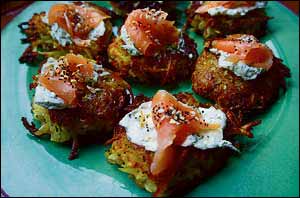| FOOD | |
| Rolls so perfect for the morning | |
WHEN I go to a kosher bakery anywhere in the world, I look for poppy seed rolls. I love them for their delicate and shiny pastry and for their sweet, inky, fruity and slightly bitter poppy seed filling.
I especially love poppy seed rolls in the morning with a strong cup of coffee or black tea. It’s a decadent deviation from a sensible breakfast, and it’s especially good on a Shabbat morning. The sweet poppy seed roll is common in Jewish and non-Jewish communities in Central and Eastern European countries from Hungary, to Poland, to Ukraine, to Romania, and more. It is particularly popular during the winter holidays. In my family, my father and I have always been big fans of this pastry, and we will search high and low for a bakery that offers the best version. We will try different rolls and debate the finer points of each pastry: Was it too sweet? Was the ratio of poppy seed to pastry good? Was the pastry soft enough? There’s a reason that poppy seed rolls don’t seem to be a wildly popular baked good — they are a bit fussy to make. The pastry is made of an enriched dough; it takes time for the dough to be kneaded into a silky smooth mass; it takes time for the dough to rise; and it takes a little focus and care to shape and form the rolls. The poppy seed filling also takes a little work, although you can buy pre-made poppy seed filling in a can if you want to make your life easier. One must grind the poppy seeds in batches, heat up several ingredients and be patient with chilling time. Patience is part of the poppy seed roll process. Yet this is the kind of pastry that offers both nostalgic satisfaction and a sense of accomplishment when baked at home. The dough is so smooth and inviting to work with, and the poppy seed filling is glossy and pleasingly deep in colour. While making this, you might feel like you’re a contestant on The Great British Bake-Off in an episode where they’ve asked you to make an ‘Old World Classic’ for the technical challenge. You might nervously hope that the filling doesn’t leak, that the dough has neither over nor under-proofed, and that there is a perfect swirl of poppy seeds inside when it is finally cooled and you make your first slice. When I’ve made this, sometimes my pastry did leak, and sometimes the swirl was not as perfect as I’d hoped for, and yet the flavour never suffered for it. Tasting the still warm roll in any of its forms always seems to erase the memory of the labour and any perceived imperfections. Fresh out of the oven and (patiently) waiting for the rolls to cool a bit, the kitchen gets filled with buttery, nutty, vanilla smells, and nothing feels more homely than that.
Shannon Sarna’s Bagel Latkes Ingredients For the latkes:
For the cream cheese:
For the everything bagel topping:
METHOD Before getting started on the latkes, I advise making the everything bagel topping and the dill cream cheese. Add softened cream cheese to a bowl and combine with fresh dill, lemon juice and salt and pepper to taste. Place back in the fridge until ready to serve. To make the everything bagel topping, mix together the sesame seeds, poppy seeds, dried garlic, dried onion and thick sea salt. Set aside. Peel and cut potatoes and onions in half. Peel garlic cloves. Place potatoes, onion and garlic through food processor for a coarse grate (you can also grate coarsely by hand). Place potato mixture to a large bowl. Add eggs, flour, salt, goat cheese and 2 tablespoons everything bagel topping mix. Heat vegetable oil in a large saute pan over medium heat. Form bite-sized mounds of latkes, taking care not to squeeze too much liquid out of the latkes. Fry until golden brown on each side, then place on a wire rack on top of a baking sheet to cool. Immediately sprinkle with a pinch of salt. When ready to serve, spread thin layer of dill cream cheese on top of each latke. Add smoked salmon on each latke and top with sprinkle of everything bagel topping. Serve while still warm.
If you have a story or an issue you want us to cover, let us know - in complete confidence - by contacting newsdesk@jewishtelegraph.com, 0161-741 2631 or via Facebook / Twitter
|
